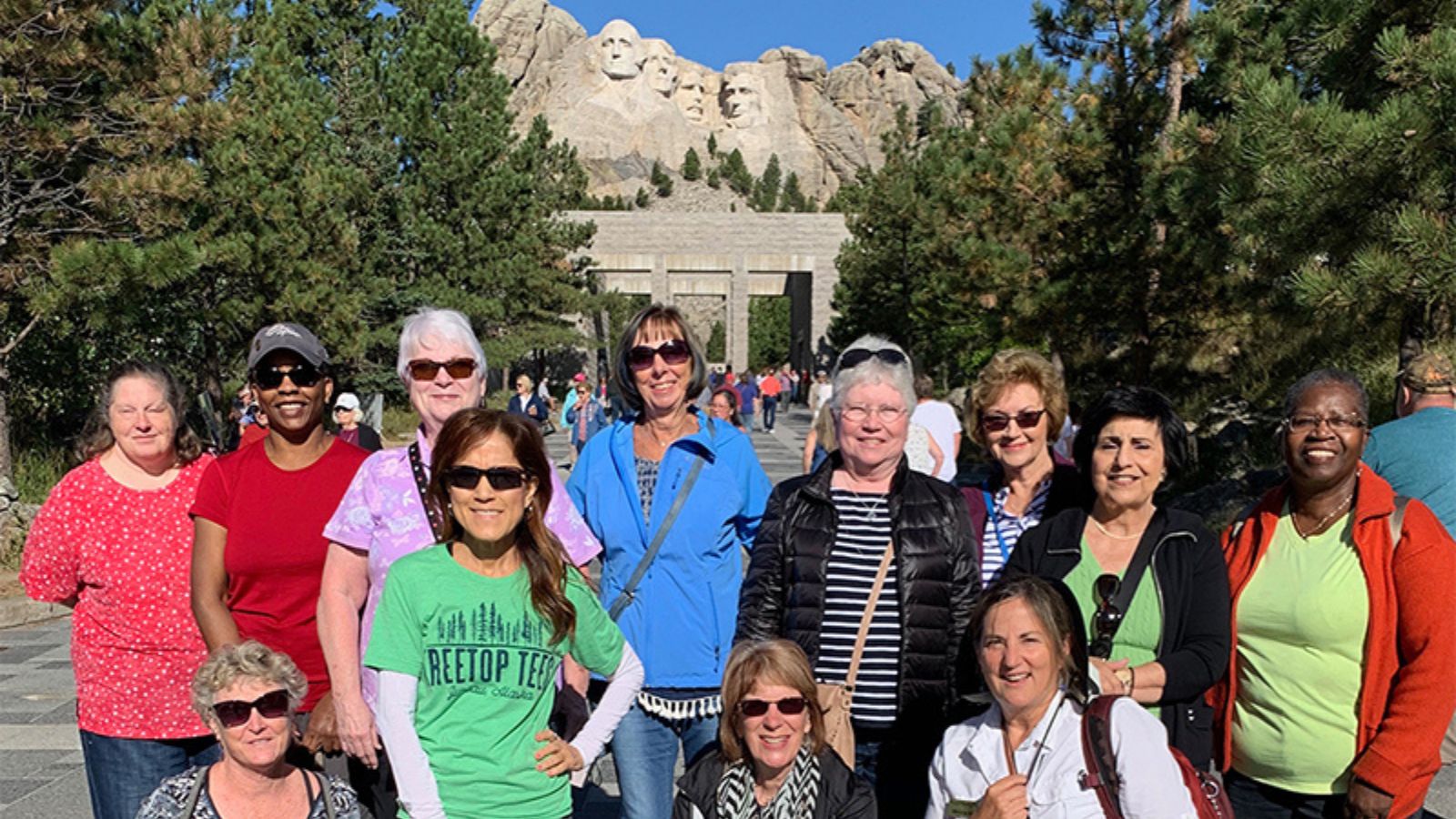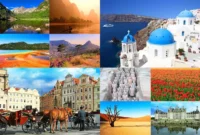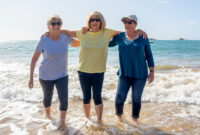Single travel groups over 50 are experiencing a surge in popularity, defying stereotypes and embracing the freedom of solo exploration. This demographic is actively seeking enriching experiences, prioritizing safety, comfort, and connection. Whether it’s immersing themselves in a new culture, embarking on an adventurous journey, or simply unwinding in a tranquil setting, mature solo travelers are redefining the meaning of adventure and proving that age is just a number.
This guide delves into the practical aspects of planning a fulfilling solo trip for those over 50, addressing key considerations such as destination selection, budget management, safety precautions, and building a sense of community. We’ll explore various travel styles, accommodation options, and transportation choices, ensuring a comprehensive and informative resource for anyone considering a solo adventure.
Popular Destinations for Solo Travelers Over 50
Planning a solo trip after 50 offers a fantastic opportunity for self-discovery and exploration. Many destinations cater specifically to the needs and preferences of mature travelers, offering a blend of cultural immersion, relaxation, and safety. These locations often boast excellent infrastructure, accessible activities, and a welcoming atmosphere.
Choosing the right destination is key to a successful solo adventure. Factors such as ease of navigation, readily available healthcare, and a generally safe environment are paramount for travelers over 50. The destinations listed below represent a diverse range of experiences, ensuring there’s something to suit every taste and budget.
Popular Destinations for Solo Travelers Over 50
This list highlights ten destinations renowned for their suitability for solo travelers over 50, considering factors such as safety, accessibility, and cultural richness.
- Portugal (Lisbon & Porto): A beautiful country with charming cities, delicious food, and a relaxed pace of life. Excellent public transport makes getting around easy.
- Italy (Tuscany & Cinque Terre): Rich in history, art, and stunning landscapes. The slower pace of life in smaller towns provides a relaxing atmosphere.
- Japan (Kyoto & Tokyo): A fascinating blend of modern and traditional culture, with efficient public transport and a high level of safety.
- Canada (Vancouver & Banff): Offers stunning natural beauty, from bustling city life to breathtaking mountain scenery. Known for its safety and welcoming atmosphere.
- France (Paris & Provence): Iconic cities and picturesque countryside offer a diverse range of experiences. While Paris can be busy, smaller towns in Provence provide a tranquil escape.
- Spain (Seville & Barcelona): Vibrant cities with rich history, culture, and delicious cuisine. Easy to navigate and generally safe.
- New Zealand (Auckland & Queenstown): Stunning natural landscapes, from fjords to mountains, with a focus on outdoor activities suitable for various fitness levels.
- Peru (Cusco & Machu Picchu): A journey through ancient history and breathtaking Andean landscapes. While altitude can be a factor, well-organized tours cater to different fitness levels.
- Costa Rica: Known for its biodiversity and eco-tourism opportunities. Many accessible activities cater to a range of interests and physical abilities.
- Ireland (Dublin & Galway): A land of captivating landscapes, friendly locals, and rich history. Relatively easy to navigate, even for first-time solo travelers.
Suitable Activities for Solo Travelers
The following activities are generally accessible and safe for solo travelers over 50, offering a balance of relaxation and exploration.
- Guided Walking Tours: A great way to explore a city and learn about its history and culture while meeting other travelers.
- Cooking Classes: Immerse yourself in local cuisine and learn new skills in a social setting.
- Museum Visits: Explore art, history, and culture at your own pace, enjoying the quiet contemplation that solo travel allows.
- Scenic Train Journeys: Relax and enjoy breathtaking views while traveling comfortably between destinations.
- Yoga or Meditation Retreats: Combine travel with relaxation and self-care in a supportive environment.
Cost of Living Comparison
This table compares the estimated monthly cost of living for a solo traveler in three of the destinations mentioned above. Note that these are estimates and can vary based on lifestyle and accommodation choices. Prices are in US dollars and are approximate.
| Destination | Accommodation (mid-range) | Food | Activities & Transportation | Total (Estimated Monthly) |
|---|---|---|---|---|
| Lisbon, Portugal | $1000 – $1500 | $500 – $800 | $500 – $1000 | $2000 – $3300 |
| Florence, Italy | $1200 – $1800 | $600 – $1000 | $600 – $1200 | $2400 – $4000 |
| Vancouver, Canada | $1500 – $2500 | $700 – $1200 | $700 – $1400 | $2900 – $4100 |
Travel Styles and Preferences
Solo travel for those over 50 offers a unique opportunity for self-discovery and exploration, tailored to individual preferences and physical capabilities. Understanding different travel styles helps in planning a fulfilling and enjoyable trip. This section explores three popular travel styles among solo travelers in this age group: adventure travel, relaxation-focused travel, and cultural immersion.
Adventure Travel for Solo Travelers Over 50
Adventure travel for this demographic often involves moderate physical activity and a focus on experiencing nature and unique landscapes. It might include hiking less strenuous trails, kayaking calm waters, or taking guided wildlife tours. While it offers the thrill of new experiences and a connection with nature, it’s important to assess one’s physical fitness level and choose activities accordingly. Overexertion can be detrimental, so choosing well-planned itineraries and considering travel insurance that covers medical emergencies is crucial.
Essential Items for Adventure Travel:
- Comfortable hiking boots with good ankle support
- Lightweight, moisture-wicking clothing layers
- A daypack with ample space for water, snacks, and a first-aid kit
- Binoculars for wildlife viewing
- A waterproof and durable jacket
Relaxation-Focused Travel for Solo Travelers Over 50
This style prioritizes rest, rejuvenation, and unwinding. It might involve staying at luxurious spas, enjoying leisurely beach days, or exploring destinations known for their tranquil atmosphere. The advantage lies in the opportunity to de-stress and recharge, fostering mental and physical well-being. However, the potential disadvantage is the higher cost associated with luxury accommodations and spa treatments. It’s also important to avoid over-scheduling and allow for ample downtime.
Essential Items for Relaxation-Focused Travel:
- Comfortable clothing, including loungewear
- A good book or e-reader
- Sunscreen and a wide-brimmed hat
- A travel-sized aromatherapy kit
- A journal and pen for reflection
Cultural Immersion Travel for Solo Travelers Over 50
This style emphasizes learning about and experiencing different cultures. It involves visiting historical sites, attending local events, interacting with locals, and trying new cuisines. The benefits include broadening one’s horizons, gaining new perspectives, and creating lasting memories. However, it may require more planning and research to ensure authentic experiences and navigate unfamiliar environments. Language barriers can also pose a challenge, but are often overcome with preparation and a willingness to connect with others.
Essential Items for Cultural Immersion Travel:
- A phrasebook or translation app
- A guidebook or travel journal
- Comfortable walking shoes
- An adapter for electronic devices
- A reusable water bottle
Safety and Security Considerations
Traveling solo, especially for those over 50, requires a proactive approach to safety and security. While the majority of travel experiences are positive, being prepared for potential challenges can significantly enhance peace of mind and ensure a more enjoyable trip. This section outlines key precautions and resources to help you travel confidently and safely.
Five Essential Safety Precautions for Solo Travelers Over 50
Prioritizing safety before, during, and after your trip is crucial for a successful solo adventure. These precautions cover various aspects of travel, ensuring a comprehensive approach to personal security.
- Pre-Trip Planning: Thoroughly research your destination, including local laws, customs, and potential safety concerns. Share your itinerary with family or friends, including flight details and accommodation information. Make copies of important documents like your passport and travel insurance policy, storing them separately from the originals.
- Accommodation Choices: Opt for reputable hotels or guesthouses in well-lit and populated areas. Consider booking accommodations with security features such as 24-hour reception and secure keycard access. Always inform the hotel staff of your planned excursions.
- During Travel: Be aware of your surroundings at all times. Avoid walking alone in poorly lit or isolated areas, especially at night. Use reputable transportation services and avoid hitchhiking. Trust your instincts; if a situation feels unsafe, remove yourself from it immediately.
- Financial Security: Use credit cards and debit cards with fraud protection. Notify your bank of your travel dates to prevent your cards from being blocked. Carry only a small amount of cash and keep it secure. Consider using a money belt or hidden pouch for valuables.
- Post-Trip Actions: Upon returning home, review your bank and credit card statements for any unauthorized transactions. Report any suspicious activity to the appropriate authorities immediately. Share your safe return with the people you informed of your travel plans.
Available Safety and Security Resources
Numerous resources and tools are available to enhance safety while traveling alone. Utilizing these tools can provide additional layers of security and peace of mind.
- Travel Insurance: Comprehensive travel insurance is essential, covering medical emergencies, trip cancellations, and lost belongings. Ensure your policy adequately addresses the specific needs of solo travelers.
- GPS Tracking Devices: Personal locator beacons (PLBs) or GPS trackers can provide real-time location information to family and friends, offering an extra layer of security, particularly in remote areas.
- Mobile Apps: Several apps offer safety features such as emergency alerts, GPS tracking, and secure communication. Research and select apps that align with your needs and destination.
- Local Emergency Contacts: Before your trip, research and save emergency contact numbers for your destination, including police, ambulance, and embassy or consulate.
- Registered Traveler Programs: Consider enrolling in your country’s registered traveler program, which can provide assistance in case of emergencies abroad.
Emergency Contact Information and Procedures
Having a well-organized plan for emergencies is crucial for solo travelers. This table outlines essential contact information and procedures.
| Contact Type | Contact Information | Procedure |
|---|---|---|
| Emergency Services (Local) | (Example: 911 in the US, 999 in the UK, 112 in Europe) | Dial the number and clearly state your location and the nature of the emergency. |
| Embassy/Consulate | (Find contact information on your country’s embassy website) | Contact them in case of emergencies involving legal issues, passport loss, or other significant problems. |
| Family/Friend (Emergency Contact) | (Name and Phone Number) | Inform them of your travel plans and check in regularly. Contact them immediately in case of an emergency. |
| Travel Insurance Provider | (Policy number and phone number) | Contact them to report any incidents covered by your insurance policy. |
| Your Bank/Credit Card Company | (Phone numbers for reporting lost or stolen cards) | Report lost or stolen cards immediately to prevent unauthorized use. |
Budgeting and Financial Planning
Planning a solo trip over 50 requires careful budgeting to ensure a comfortable and enjoyable experience without overspending. A well-structured budget allows for flexibility and peace of mind, preventing financial anxieties during your travels. This section will guide you through creating a realistic budget and utilizing cost-saving strategies.
Creating a Realistic Travel Budget
Begin by identifying your trip’s duration and desired destinations. Research average costs for accommodation, transportation, activities, food, and miscellaneous expenses in your chosen locations. Online travel aggregators and forums can provide valuable insights into realistic pricing. Consider using a spreadsheet or budgeting app to track your expenses. Allocate a specific amount for each category, leaving room for unexpected costs. A contingency fund of 10-20% of your total budget is recommended to cover unforeseen circumstances, such as medical emergencies or flight delays. For example, a two-week trip to Southeast Asia might require a budget of $3000-$5000 depending on your travel style, while a similar trip to Europe could cost $4000-$7000 or more. Remember to factor in visa fees, travel insurance, and any necessary vaccinations.
Cost-Effective Accommodation and Transportation Options
Choosing budget-friendly accommodation and transportation significantly impacts your overall travel expenses. Instead of luxury hotels, consider options like guesthouses, Airbnb rentals, or hostels (if comfortable with shared facilities). For transportation, utilize public transportation whenever possible, as it’s usually cheaper than taxis or ride-sharing services. Consider purchasing travel passes for unlimited rides within a specific timeframe. For longer distances, explore budget airlines or overnight buses, which can be considerably more affordable than trains or private cars. For instance, staying in a guesthouse in a smaller town rather than a hotel in a major city can save hundreds of dollars over the course of a trip. Similarly, taking a bus from one city to another instead of flying can dramatically reduce travel costs.
Utilizing Travel Rewards Programs and Discounts
Leveraging travel rewards programs and discounts can substantially reduce travel costs. Accumulate points or miles through credit card spending and airline loyalty programs. Redeem these points for flights, hotel stays, or other travel-related expenses. Take advantage of senior citizen discounts offered by many airlines, hotels, and attractions. Consider purchasing a travel pass offering discounts on multiple attractions in a specific region. Websites and apps dedicated to travel deals can help you find discounted flights, accommodation, and activities. For example, booking flights and hotels through a travel rewards portal can often yield significant savings, and many museums and attractions offer reduced admission fees for seniors. Thorough research and planning can unlock considerable cost savings.
Building Connections and Community
Traveling solo doesn’t mean traveling alone. For those over 50, embracing opportunities to connect with fellow travelers and locals can significantly enrich the experience, fostering a sense of belonging and creating lasting memories. This section explores various avenues for building community during solo adventures.
One of the most effective ways to meet like-minded individuals is through participation in group tours and activities specifically designed for solo travelers. These curated experiences provide a built-in social structure, offering opportunities for interaction and shared experiences.
Group Tours and Activities for Solo Travelers
Many tour operators cater specifically to the 50+ demographic, recognizing the unique travel preferences and needs of this age group. These tours often focus on slower paces, comfortable accommodations, and enriching cultural experiences rather than fast-paced adventure tourism. For example, a small-group walking tour of a historical city center, focusing on local history and culinary experiences, provides ample opportunity for interaction with both fellow travelers and local guides. Similarly, a guided cycling tour through scenic countryside, with breaks for picnics and local interactions, fosters a sense of camaraderie amongst participants. These types of tours frequently incorporate opportunities for informal social gatherings, such as welcome dinners or post-tour drinks, further facilitating connection. Cruises also represent another excellent option, offering a range of organized activities and shared dining experiences.
Online Communities and Forums
The digital world offers a powerful platform for connecting with other solo travelers before, during, and after a trip. Numerous online communities and forums are dedicated to solo travel, providing a space to share experiences, seek advice, and even arrange meetups with other travelers in specific destinations. Websites and social media groups dedicated to 50+ travel often feature threads and discussions specifically focusing on solo travel within that age group. These online spaces allow for pre-trip planning and coordination, facilitating the formation of travel buddies or simply providing a sense of support and shared experience. Participants can exchange tips, share itineraries, and even coordinate meeting up at certain destinations or activities. This pre-trip connection can significantly reduce the sense of isolation often associated with solo travel.
Conclusive Thoughts
Embarking on a solo journey after 50 offers a unique opportunity for self-discovery, personal growth, and the creation of lasting memories. By carefully planning your trip, prioritizing safety, and embracing the chance to connect with new people and places, you can unlock a world of enriching experiences. Remember that the journey itself is as rewarding as the destination, so savor each moment and let your adventurous spirit guide you. The world awaits!




